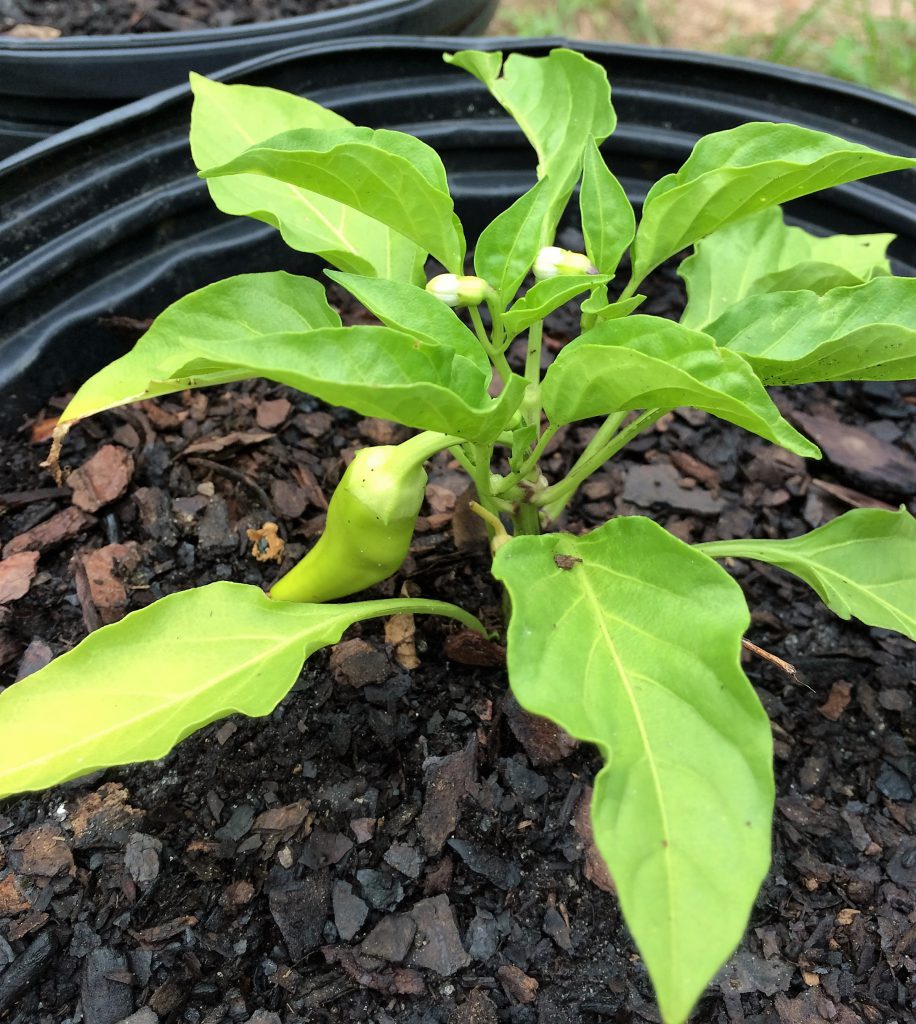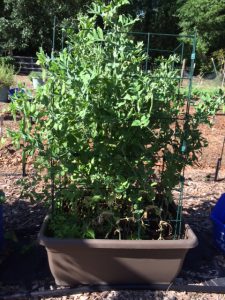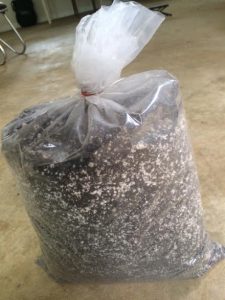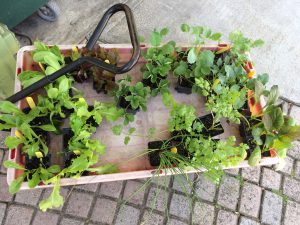
Interested in having a garden, but have limited space? Maybe you live in an apartment, have poor soil quality, or you just don’t have many areas that get enough sunlight. Maybe you’ve tried gardening, but given up, labeling yourself as one of those who “just doesn’t have a green thumb.” Well, I’m here to tell you, don’t give up! Try container gardening. Growing your own vegetables in containers is easy and can be a very rewarding experience. Container gardens also tend to have fewer weed, pest, and disease problems then regular in-ground gardens. Following just a few guidelines, you can have a bountiful harvest of fresh fruits, vegetables, and herbs right by your front (or back) door-step!

So, what are these guidelines, you ask? Well, you first want to choose the right container. This could be a large flowerpot, window box, planter, 5-gallon bucket, half-barrel, recycled material…the list can be endless. Just as long as your container is big enough and has proper drainage. Generally, the container should be at least 10 inches wide and 10 inches deep. The bigger the better, as it will give the roots more space to grow, and the soil will not dry out as fast. Tomatoes, for instance, do best in larger pots, preferably the size of a five-gallon bucket. For many herbs, you can get away with planting two or three different types in the same container. It is also important that your container has drainage holes, so water can escape and air can circulate. Use a one-fourth inch drill bit to create holes in the bottom or along the sides near the bottom of the container if it does not have holes.
Most of us know plants need both sunlight and soil. But just how much sunlight and what type of soil? If you are growing vegetables, it is best to have full sun – which means at least six hours of direct sunlight per day. An advantage of growing in containers is that you can easily place a container in an area of your yard or on a balcony that receives adequate sunlight, when it would be much more difficult to build a garden in these same areas.

So what about soil? When growing in containers, you want to make sure you get potting soil that is made for containers. These mixes will contain materials such as peat, perlite, and vermiculite for both good drainage and moisture-holding capacity, and materials such as compost and nutrient amendments that will keep your plants healthy. You can simply ask your nursery specialist for a mix formulated to grow vegetables in large outdoor containers. If you are growing a lot of vegetables, you can cut down on costs by making your own mix. Just make sure you have a good balance of the aforementioned materials, and mix in a slow-release vegetable fertilizer, following directions on the label.
Now that you have your container, your soil, and a sunny location, it is time to get the plants. Some plants are best bought as transplants or grown from seed started indoors. Vegetables such as broccoli, collards, kale, tomatoes, eggplant, peppers, and strawberries fall into this category. Other plants, such as root crops, arugula, lettuce, spinach, mustards, beans, peas, cucumbers, squash, okra, cilantro, and basil can be started from seed directly into containers.

Okay, so you have all the materials. Now what? If you are growing from transplants, first thoroughly moisten the potting mix and the plant’s soil. “Transplant shock” is reduced when there is proper moisture. Set plants at about the same level they were growing in their original pot. For tomatoes, remove lower leaves and plant deeper in the container. If you are growing from seed, simply plant the seeds according to their label. A good rule of thumb is to plant the seed to a depth of about two to three times the seed’s diameter. If you are worried about your seeds not germinating, go ahead and plant more seeds than you need. But remember to thin to appropriate spacing if they do, indeed, all come up. Spacing will be specific to the type of vegetable.
After planting, water gently but thoroughly. Monitor your container garden, making sure the potting mix does not dry out. You can reduce evaporation by mulching with leaf litter, straw, or a similar material. Plants that grow tall or produce vines, such as tomatoes and cucumbers, will need support. A wire cage or pole, inserted into the container at planting time, will support the plant as it grows.
Last step is to call over all your friends and family and show off your beautiful vegetable plants! They will surely be impressed by your “green thumb” and will be eager to learn your gardening secrets.
 0
0

Comments:
September 21, 2021
Hi Sara, Thank you for your comment! Edible ginger, Zingiber officinale, is not considered invasive and can be planted in the soil or in a pot. Here is more information, including additional links about ginger, how to grow it, and how to harvest the roots: https://gardeningsolutions.ifas.ufl.edu/plants/edibles/vegetables/ginger.html Thank you and please let us know if you have any additional questions! Sincerely, -UF/IFAS Leon County Extension
September 20, 2021
Is edible ginger invasive or does it have a lot of spread (like Boston? ferns)? The ginger sprouted in a pot from buying a fresh organic root at the grocery store. Should I plant the ginger in my yard or keep it in a pot?
October 7, 2020
It may be an urban legend, but I've heard that they irradiate or treat some ginger to prevent it from growing. I always look for fresh growth nubs on ginger if I'm looking for some for planting.
August 22, 2016
Hi Ann, Sorry for the confusion. What I meant to say is that while spinosad is safe in vegetable gardens, not all organic materials are safe. Rotenone and nicotine sulfate are examples of organic materials that are not safe in vegetable gardens. Does that help? -Molly Jameson
August 20, 2016
Must be in the same family as the cypress vine - it stinks too.
August 19, 2016
In paragraph six it states that spinosad is safe for use in vegetable gardens. And then in the same paragraph say it should not be used in a vegetable garden. I'm confused. Is it okay? I've tried everything. Digging it up. Boiling water. Cinnamon. Thanks, Ann
August 12, 2016
Great Article! Thank you. Dmytro
August 3, 2016
This is the best organic way of dealing with waste. I started researching compost opportunities while ago. This is the future if we want to keep the planet's environment and resources, of course. I didn't know much about vermicomposting, only about the standard composting methods. I know most people are used to hire a company for their waste removal needs but it is good if they consider at least to try your composting method. Thank you, Sheryl
July 7, 2016
I believe that proper and regular garden waste clearance could significantly reduce the risk of your plants getting affected by fungus and bacteria. It doesn't require much effort and if you don't have the time to do this by yourself you could always hire professional rubbish removal service.
May 25, 2016
couple of comments.....(1) As an organic farmer, mushroom compost seemed a no-brainer addition to my yearly mulch pile. However, I stopped using it a couple of years ago because of an article discussing the chemicals the mushroom folks use to reduce certain diseases peculiar to mushroom. (2) I also used straw bales to boarder three sides of my yearly mulch/compost pile and then at the end of the year incorporated the rotted straw into the compost as a "plant-based manure." However, a couple of years ago I came to understand that since straw is generally not consumed when used as a bedding material, straw farmers liberally sprays their fields with herbicides to improve the straw's "purity" from weeds Again, concerned with residual chemicals I discontinued using straw. Results from (1) & (2) = my raised-bed garden with 100% organic growing medium (no dirt) has yielded healthier plants and better crop yield. Took two years, with each year showing improvement. CONCLUSION: carefully "vet" the origins/history of the ingredients that go into your compost so you can more closely realize that garden of your dreams!
April 27, 2016
I've been growing container veggies on my deck for years. Some don't do so well and others are astounding! Tomatoes never did well for me in-ground, but large pots on the deck are perfect. Green snap beans, banana peppers and salad greens too. what few pests found are easily disposed of and soil borne troubles are nil. I will never go back to any other system.
April 26, 2016
The best time to plant potatoes here is in January/February. Also, russet potatoes are more commonly grown in more northern climes and generally not grown in Florida. See our publication on potatoes: http://edis.ifas.ufl.edu/pdffiles/HS/HS18300.pdf But you can give it a try and see what happens!
April 25, 2016
Nice piece! Proud of the work of this great organization, a model for all of Florida and the country.
April 21, 2016
http://pasco.ifas.ufl.edu/gardening/mulches.shtml This should explain the situation well. Thanks!
April 16, 2016
why is cypress mulch not recommended for use as mulch?
April 11, 2016
My husband wants to plant a MICROWAVE Able potato. It is all ready wrapped in Plastic. It has roots growing out. We got it at Publix. It is called MICRO TATER Russet. Is it worth doing it. ?
October 9, 2015
Wonderful article! Thank you! Makes me feel better about wanting to eat peanuts in ways besides the traditional Southern way which has too much salt.
September 5, 2015
I live in the fountain area, and I know I will not have the lush green grass I had in Nebraska, I have problems in my yard I do not know what to do about. Yes I have lots of turkey oaks with white around them that seems to kill the tree after time. But my main concern is I will have a nice green patch of grass, but then the edges die. Sometimes a big circle will be there with just weeds growing in it. I also have a vine that goes underbeath the soil and kills plants I can get to grown. I also have a tree in my yard that almost has leaves like a mimosa but is bright orange in the fall. Can you heip. I do not know when to go to get answers for my questions
August 28, 2015
Thank you so much for focusing on this important topic! Since moving to FL not as connected to local sources as was in NM. But I will continue to seek out local vendors, growers, farmers. I always grow things myself. Lia
June 23, 2015
Food waste is a worldwide problem, but in the US it seems it is the most major issue, excluding hazardous waste... Recently many supermarkets began a program in which they use their waste to convert it into power and use that power. As a professional dealing with almost any kind of waste, household rubbish and house clearances in London, I can really say that now is the time to make innovations and start the change - to recycle more and to produce less waste.
February 5, 2015
Great article!
January 23, 2015
Excellent article Taylor - very important. Donna
August 12, 2014
Donna, Thank you for the information! I will definitely add it to my list. Taylor
August 5, 2014
Hi Taylor You might want to add the native hoptree (Ptelea trifoliata) and the herb rue to your list for larval plants for the giant swallowtail. Rue fits nicely in the butterfly garden and also is used by black swallowtails. Hoptree can be used outside of the garden since it makes a small tree or large shrub, doing well in a lightly shaded mixed border. Enjoyed the article. Donna Native Nurseries
July 3, 2014
Sounds like you have a very nice wildflower garden!
July 3, 2014
Thanks, Taylor! Great info!
July 3, 2014
About 15 years ago, I attended a slide-illustrated program at a Garden Club meeting. The Florida DOT's District 1 staff person for road-side wildflowers was the presentor. The Wildseed Co. of Fredericksburg, TX was recommended as source for our home landscapes. I have been planting this company's Southeastern US mix..and cosmos specialty seeds...ever since. I love to give small bouquets. I love to look at my beds in front and read of my home. In addition,my photo of coreopsis in a roadside ditch won "First Place" in photo contest! Lois Jones / Marianna since 2000; previously-Chipley
May 1, 2014
Great information! Thank you.
May 1, 2014
Hello Taylor: Thanks for the diagnosis flow charts! I have a fruit and vegetable garden at home in addition to our landscaping, and what would be helpful is a couple of definitions, and some instructions what to do once we've diagnosed the problem. Hopefully at some point someone wrote an article about how best to do that, and perhaps you could add a link. With regard to definitions, what are mobile vs. immobile nutrients? I would think "necrotic" means something similar to yellowed or scorched, but since you used the latter terms in other places in the charts, does it mean something different? What does "chlorotic" mean? Thanks for any additional information you can provide. -- Sharon McAuliffe
February 26, 2014
Thanks for the info, now are there sources for any of mentioned plants? I live in Eastpoint-Apalachicola, FL. I did have my sandy soil tested and it is very high-very sandy!
January 22, 2014
nice article, Taylor - I'm looking forward to planting our potatoes soon.
November 6, 2013
Worm composting like any other job, does require a lot of skills and patience...
November 5, 2013
Thanks for sharing a great article on vermicomposting
Comments are closed.